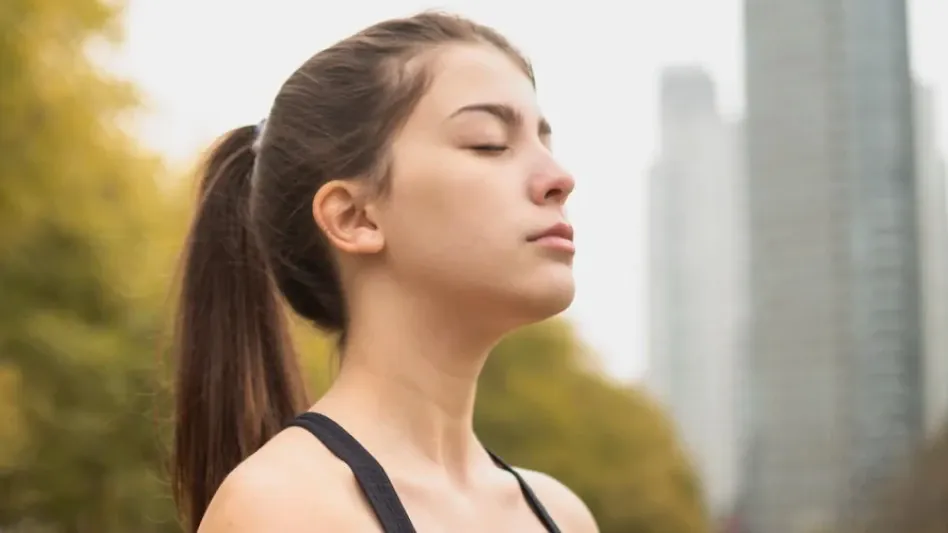Many people do not breathe well because we live in a world that exposes us to psychological, social, and economic pressures, as well as challenging work environments. These factors cause us to breathe under stress, affecting our ability to face challenges. This is where the importance of breathing exercises comes in. Research has shown that slowing down our breathing can relieve stress and improve mood through the subtle and profound impact our breathing has on how we think, feel, and behave. Our breath accompanies us from birth to death, making it an immediate tool available to humans for self-regulating emotions.
1. Monitor Your Posture
Breathing can be done lying down, sitting, standing, or even while walking. However, for mindful breathing, it’s best to sit still on a chair with both feet on the ground for easier breathing, says Dallaghan. Paying attention to your posture plays a crucial role in effective breathing exercises. When you sit with a straight back and your feet flat on the ground, it allows your lungs to expand fully, which promotes deeper and more efficient breaths. An unsupported posture can lead to shallow breathing, reducing oxygen intake and making it harder to manage stress.
Proper posture is not only about sitting in a chair but also about how you carry yourself throughout the day. Whether standing, walking, or even lying down, maintaining a posture that supports optimal lung function can make a significant difference. This focus on posture is essential because slouching or poor alignment restricts the diaphragm’s movement, making it difficult to achieve the full benefits of slow, controlled breathing. By being mindful of your posture in various daily activities, you can create a habit that supports better breathing patterns and, consequently, a more relaxed and focused state of mind.
2. Take Gentle, Quiet Breaths
Christian Brembs, a professor of psychiatry and behavioral sciences, advises, “Breathe gently, silently, and precisely. Loud breathing indicates stress and signals danger to our nervous system.” Let breathing be soft and quiet rather than deep, as deep breathing can create additional tension. Taking gentle and quiet breaths is fundamental in achieving a state of calm and relaxation. Loud or forced breaths can stimulate the body’s stress response, which is counterproductive to the goals of slow breathing exercises. By focusing on gentle and silent inhalations and exhalations, you communicate to your nervous system that everything is safe, which helps to reduce anxiety and promote tranquility.
In addition to lowering stress levels, gentle and quiet breathing can enhance your overall breathing efficiency. When you breathe softly and quietly, it encourages a natural and smooth airflow, which can improve oxygen exchange in your lungs. This can lead to greater energy levels and mental clarity throughout the day. Moreover, practicing gentle breathing can help you become more aware of your breath, which is an essential component of mindfulness practices. This heightened awareness can make it easier to notice when you are feeling stressed or anxious, allowing you to use your breath to bring yourself back to a state of calm.
3. Breathe Through Your Nose
Brembs recommends focusing on “learning to breathe quietly through the nose at all times,” including at night and during exertion. Nose breathing has numerous benefits, such as increasing oxygen absorption, filtering and humidifying air, and regulating its temperature. Breathing through your nose is a natural and efficient way to breathe that offers several physiological advantages. The nasal passages filter out particles and pathogens from the air, protecting your respiratory system from potential irritants. Additionally, the nose warms and humidifies the air before it reaches your lungs, which can prevent respiratory issues and make breathing more comfortable.
Another significant benefit of nose breathing is that it helps to regulate the amount of oxygen and carbon dioxide in your blood. This balance is crucial for maintaining optimal bodily functions and ensuring that your brain and muscles receive the oxygen they need to perform effectively. By breathing through your nose, you can also improve your focus and concentration. The slow and controlled nature of nose breathing can help to enhance cognitive functions and promote a sense of calm and well-being. Practicing nose breathing consistently can lead to long-term improvements in your overall respiratory health and stress management.
4. Expand Your Breath Awareness
If you only feel your breath in your chest, “your breath is not deep enough,” says Dallaghan. He advises placing one hand on your belly above the navel and the other below your chest “to feel the movement of your abdominal muscles and diaphragm during breathing.” Expanding your breath awareness involves understanding and controlling the full extent of your breathing capacity. By becoming more aware of how you breathe, you can ensure that you are using your diaphragm effectively, which promotes deeper and more efficient breaths. Placing your hands on your belly and chest can help you feel the movement of your diaphragm and abdominal muscles, providing a physical cue to guide your breathing practice.
Deep breathing that involves the diaphragm, also known as diaphragmatic or belly breathing, can significantly enhance your lung capacity and oxygen intake. This type of breathing activates the parasympathetic nervous system, which helps to reduce stress and promote relaxation. By practicing diaphragmatic breathing regularly, you can train your body to use this more effective breathing method naturally, even in stressful situations. Expanding your breath awareness not only improves your physical health but also enhances your mental and emotional well-being, making it easier to manage stress and maintain a positive mood.
5. Experiment with Different Breathing Patterns
Try techniques like spending equal time inhaling, holding your breath, exhaling, and holding your breath again, with each step lasting 3–4 seconds. Alternatively, inhale for 4 seconds, hold your breath for 7 seconds, and exhale for 8 seconds. Cyclical sighing can also be practiced by inhaling slowly, then inhaling again to fill the lungs before exhaling slowly. Practices like yoga and meditation can also help slow breathing. Experimenting with different breathing patterns can help you find the most effective techniques for your individual needs. Various breathing exercises target different aspects of your respiratory system and can offer unique benefits.
By trying different breathing patterns, you can discover which methods help you achieve the greatest sense of calm and balance. For instance, the 4-7-8 technique, which involves inhaling for 4 seconds, holding the breath for 7 seconds, and exhaling for 8 seconds, is known for its ability to reduce anxiety and promote relaxation. Cyclical sighing, a method where you take a slow inhalation, followed by another breath to fully inflate the lungs before a gradual exhalation, can also help to reset your breathing pattern and alleviate tension. Incorporating these techniques into your daily routine can enhance your ability to manage stress and improve your overall well-being.
6. Breathe Longer and More Often
Many individuals struggle with proper breathing due to the pressures of modern life, including psychological, social, and economic stressors, along with demanding work environments. These factors lead us to breathe in a way that reflects stress, which in turn affects our capacity to tackle life’s challenges effectively. This is why breathing exercises are so crucial. Scientific studies have shown that deliberately slowing down our breathing can significantly reduce stress levels and improve our mood. This is due to the profound, yet subtle, influence that breathing has on our thoughts, emotions, and behavior. Breathing is a constant companion from birth until death, providing us with an ever-present tool to self-regulate our emotions. Therefore, by focusing on our breathing patterns and engaging in regular breathing exercises, we can gain better control over our mental and emotional state, leading to improved overall well-being. Using our breath wisely can be a significant asset in managing the stresses of daily life.









